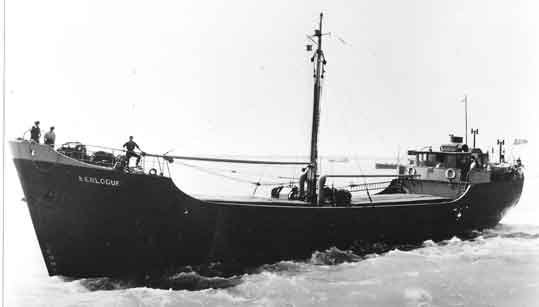By Fran O’Rourke
The Battle of Biscay, on 28 December 1943, was a significant episode in the Second World War. Two British cruisers, HMS Enterprise and HMS Glasgow, sank two German torpedo boats and a destroyer which were in the area to escort a supply ship through the British blockade. Germany subsequently changed its strategy and henceforth only tried to break the blockade with U-boats.

Of the 672 men on the three sunken ships, 60 were rescued by British minesweepers but an astonishing 168 by a small Irish steamer, the MV Kerlogue. Owned by the Wexford Steamship Co., the 354-ton MV Kerlogue was en route from Lisbon to Dublin with a cargo of oranges on 29 December when a German plane flew overhead signalling ‘SOS’, indicating that the boat should follow it in a south-easterly direction. After two hours Captain Tom Donoghue and his men came upon the appalling aftermath of the naval battle, 350 miles south-west of Cork. The sea was littered with corpses in life-jackets and men desperately clinging to wreckage.
For ten hours, in rough seas until after dark, the exhausted crew of the Kerlogue hauled men onto the small 140ft craft, cramming them into every corner of the vessel until Captain Donoghue issued the stark order, ‘No more, or we’ll sink’. The crew distributed their spare clothes and gave what first aid they could. The cargo of oranges saved the survivors from dehydration. A crew member later wrote:
‘Cabins, storerooms and alleyways were soon packed with shivering, soaked and sodden men; others were placed in the engine room where it became so crowded that the engineer could not attend his machinery, and so by signs—as none spoke English—he got the survivors to move the instruments he could not reach.’
Lieutenant-Commander Quedenfelt requested that the ship sail for German-occupied France but Captain Donoghue refused. The Germans could easily have commandeered the ship but respected his authority.
At 22.00 hours on 31 December, 30 miles south of Fastnet Rock, Captain Donoghue sent a message by Morse code to Valentia coast station:
‘Proceeding Cobh expect arrive two am tomorrow morning. Have on board 164 seamen survivors seven men seriously injured one man dead [in fact three others had already died]. Please instruct Port Control Cobh that I request urgent medical assistance. Have no food water or clothing. Thomas Donoghue Master.’
Valentia acknowledged the message and signed off with ‘Well done, Kerlogue’. Shortly afterwards, the British Admiralty at Land’s End broadcast a message, repeated every fifteen minutes, ‘Proceed direct to Fishguard in accordance with navicert’. The navicert was the British permit that allowed neutral ships to sail, on condition that they report to a designated port on both the outward and homeward trips. Captain Donoghue ignored the order.
The Kerlogue docked at Cobh on 1 January 1944. The wounded were brought to hospital, the rest to Collins Barracks before being transferred to the Curragh. Two days later the Kerlogue sailed to Fishguard to comply with the navicert. There the senior British naval officer expressed his fury at Donoghue for disobeying orders to land first at Fishguard. Donoghue replied that his primary concern was to save lives. Other officers later apologised to Donoghue and congratulated him on his selfless heroism.
The rescued Germans were interned in the Curragh military camp until the war’s end. They considered themselves lucky not to be deported to England. Conditions in the Curragh were comfortable. One internee wrote home: ‘The food here is beyond all praise. I don’t exaggerate when I say that we get twice as much to eat as on board, meat in large portions, white bread and good butter, fresh milk and five cigarettes daily.’ A library of 400 books, many in German, was established.
The internees attended the Curragh races and went on day trips to Dublin. Some worked for local farmers, thinning beet and saving hay. They sold their homemade doughnuts at the Curragh races and gained a reputation for repairing clocks and radios. Some attended courses at University College Dublin.
In June 1945 the internees were handed over to the British Army. The Irish government had been given an assurance that they would be transferred directly to Germany. They were instead transported to Belgium and billeted in a military prison near Brussels. In October 1945 they were repatriated to Germany.
A ceremony to mark the 50th anniversary of the rescue was held in the National Maritime Museum, Dún Laoghaire, in 1994, attended by President Mary Robinson. Twenty survivors were present and a squadron of six German minesweepers was docked in the harbour. Two crewmen from the British HMS Glasgow and HMS Enterprise came from England and South Africa.
An exhibition to mark the 80th anniversary of the Kerlogue rescue will open in the National Maritime Museum, Dún Laoghaire, on 25 May 2024.
Fran O’Rourke is Emeritus Professor of Philosophy at University College Dublin (www.franorourke.ie).
